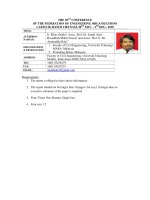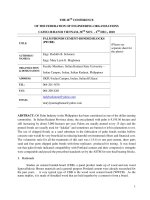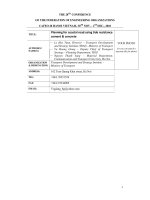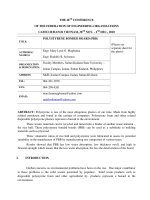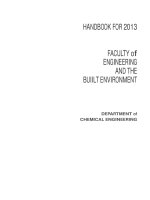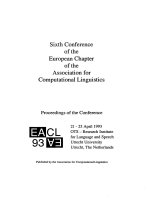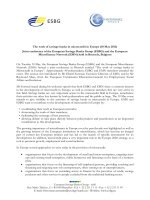THE 28TH CONFERENCE OF THE FEDERATION OF ENGINEERING ORGANIZATIONS
Bạn đang xem bản rút gọn của tài liệu. Xem và tải ngay bản đầy đủ của tài liệu tại đây (160.82 KB, 8 trang )
1
THE 28
TH
CONFERENCE
OF THE FEDERATION OF ENGINEERING ORGANIZATIONS
CAFEO 28 HANOI VIETNAM, 30
TH
NOV. - 2
ND
DEC., 2010
TITLE:
Planning for coastal road using tide resistance
cement & concrete
YOUR PHOTO
(or you can attach a
separate file for photo)
AUTHOR(S)’
NAME(S):
— Ly Huy Tuan, Director – Transport Development
and Strategy Institute (TDSI) - Ministry of Transport
— Vu Hoang Giang – Deputy Chief of Transport
Strategy – Planning Department, TDSI
— Nguyen Thanh Sang – Material Department,
Communication and Transport University, Ha Noi
ORGANIZATION
& DESIGNATION:
Transport Development and Strategy Institute -
Ministry of Transport
ADDRESS:
162 Tran Quang Khai street, Ha Noi
TEL:
+844. 39351524
FAX:
+844.3.9344069
EMAIL:
2
Technology and technique for a better life can cope
with climate change
Topic: Planning for coastal road using tide resistance cement &
concrete
Background
Currently, Vietnam as well as other countries around the world are faced with
changes of climate phenomena, such as global warming, melting ice, rising sea
levels,...; the climate change is much bad causes to the general activities of man. The
characteristics of Vietnam's long coastline, the coastal road system has an important
role in the economic and social development, national defense - national security.
Ensuring the sustainable development of coastal road system before the change of
climate, sea level rise is an urgent problem and deserve attention.
Solution: the current of the coastal road system (direction, structure, technology use,
....), the problem must be solved.
1. Viet nam in general view
1.1. Geography Condition
Vietnam located in the Indochina Peninsula, belongs to South East Asia.
Vietnam's territory runs along the east - coast of the peninsula. Vietnam has borders
with China (1281 km), Laos (2130 km) and Cambodia (1228 km) and 3444 km long
coastline bordering the Bac Bo gulf, South Sea and Thailand Gulf.
Vietnam has an area of 331,212 km ², including approximately 327,480 km ²
land and more than 4200 km ² sea inland, with more than 2800 islands, reefs - big and
small, near and offshore, including the Truong Sa and Hoang Sa, which belongs to
Vietnam, is internal waters, territorial sea, exclusive economic zone and continental
shelf of the Vietnam’s Government is determined almost three times the interior area
of over 1 million square kilometers.
Vietnam’s terrain is very diverse as natural areas like the North West, North
East, Highlands is full of hills and mountain forests, while the flat land covering
about les than 20%. About 40% of mountains, 40% of hill, and its coverring is about
75%. The plains as the Red River Delta, the Mekong River delta and coastal areas
such as coastal North Central and South Central Coast. Overall, there are three
domain areas in Vietnam: northern highlands and the Red River delta, central part
with coastal lowlands, the highlands run along the Truong Son mountain, and south is
the Cuu Long river Delta. the highest point of Vietnam is 3143 meters, at the top of
Fansipan, belongs to the Hoang Lien Son mountain range.
Vietnam has a tropical climate in the South with two seasons (rainy season,
from mid May to mid September, and the dry season, from mid October to mid April)
and monsoon climate in the north with four seasons (spring, summer, autumn and
winter). Lying along the coast, the climate of Vietnam is regulated by ocean currents
and having climatic factors of sea. The average relative humidity is 84-100% all year.
Annual rainfall from 1200 to 3000 mm in some places and could cause more
flooding, nearly 90% of rain falling in summer. The average annual temperature in
the plain generally slightly higher than the mountains and plateaus. Temperature
varies from a lowest. of 5°C from December to January, the coldest month, for more
3
than 37°C in April, the hottest month. The division of the season in the north more
clearly than in the southern, where the only exception of the highlands, seasonal
temperature difference is only a few degrees, usually around 21-28 C. Every year,
Vietnam always have to against to 5 to 10 storms and flooding per year.
1.2. The impact on the coastal road works.
The impact of sea level rising is extremely serious when Viet nam has the coastline of
3260km, over 1 million km2 territorial waters, over 3000 islands near the shore and
two offshore islands, many low-lying coastal areas have to suffered from heavy
flooding during the rainy season and drought, stalinization, dry seasons .ect. Climate
change and sea level rising will exacerbate this situation, increasing flooded,
drainage, increased coastal erosion and salinization of water sources, affecting
agricultural production and refresh water, risk for coastal construction projects like
roads, ports, factories, cities and residential areas.
The ports include docks, storage yards, warehouses are designed in the present
sea level will must be renovated again, even have to move to another place. The
railway north - south roads and near the seaside of road systems will be affected. The
rising level of the sea water will cause flooding, particularly in the Mekong Delta
(MD), Ho Chi Minh City, Vung Tau, Xuan Thuy (Nam Dinh). Population of coastal
areas will be flooded, every year works, infrastructure roads will be affected
seriously.
2. Overall planning of the coastal road and the actual using of cement concrete
materials
2.1. Overall planning of the coastal road
Coastal road for economic-social development, tourism, contributing to relief
and disaster prevention; national security.
As planned was approved by the Prime Minister, the coastal route starts at Port
Red Mountain, Mui Ngoc Quang Ninh province to the border gate in Ha Tien, Kien
Giang province, about 3041 km.
The coastal route is planned to be near the sea, formed on the basis of
connecting many existing roads (including national highways, provincial roads, rural
roads) is combined with investment in new works, connections with national and
regional planning, regional. In particular, the coastal route can be combined with sea
dyke systems and systems of coastal defense in order to facilitate the handling of
situations dealing with natural disasters and strengthen national defense and security
area.
The general size:
Minimum size of the coastal route as follows:
- North: from Quang Ninh to Ninh Binh: 3
th
level
- North Central near the sea (các tỉnh từ Thanh Hoá tới Quảng Trị): 3
th
level
- Mid central part (from Thua Thien Hue to Binh Đinh): 3
th
level;
- South Central part (from Phu Yen to Binh Thuan): 4
th
level;
- East South (from Ba Ria Vung Tau to Ho Chi Minh city): 4
th
level ;
- West South (from Tien Giang to Kien Giang): 4
th
level ;
4
2.2. The use of cement concrete roads in Vietnam
Actual using of cement concrete materials in road construction mainly focused
on the rural road network from the commune level or lower units (roads, village
roads). According to statistics, the total number of km of cement concrete is 22,227
kilometers (approximately 9%, not to mention urban roads and special roads), in
which the ratio of cement concrete road for rural roads peak areas (18,898 km,
covering over 85%), the lowest provincial roads (211 km, covering 0.95%), the
highway is 626 km, accounting for 2.82% (mainly Ho Chi Minh Trail and some of
the highways were flooded in flood season).
If we involve the using the cement concrete according to areas, it is showed
that: the North Central region has had the highest percentage (over 78%), while other
areas as cement concrete road rate is very low (below 5%), this shows us (especially
rural roads) using cement concrete is not popular in some areas.
2.3. The issues for building roads made of concrete cement coastal
2.3.1. Capacity to applying materials
As planned in development of cement industry was approved by the government, the
demand for cement in Vietnam in 2005 was 29 million tons, 2010 is 46 million tons
and 2015 is 62 million tons in 2020 is 68 [5]. At the moment, domestic cement
production is still excess production capacity, specific statistics in 2010, the quantity
to provide more than the factual demand to use is 5 million tons.
Cement yield to produce cement concrete is a lot, but type of cement is not
abundant, especially cement used in construction for roads in coastal areas, this type
of cement should have the characteristics of drag bending strength and ability to
sulfate. Moreover, to facilitate the using of cement in construction works in general,
and in particular the coastal road will require construction of norms and legal
provisions enabling the contractors to use Blended Cement Portland (PCB) is
currently popular on the market.
In road building with materials cement concrete, to minimize the using of more
cement that polluted environment, there may be many kinds of mineral additives used
in combination with cement like fly ash, blast furnace slag, rice husk ash, silica... It
should use the three component binder (portland cement-slag-fly ash shrine) to make
cement concrete to withstand the impact of sea water.
Currently, the type mineral additives can be manufactured in Vietnam, because
it is an indispensable component when producing cement concrete with special
requirements, morever, using mineral additives to reduce the amount of cement in and
increase using the industrial solid wastes are intended to reduce CO2 emissions in the
environment.
Fly ash has an important role in producing high performance concrete. C.
Muller, and Peter R. Hardtl Schielbl [6] when they researched on X ray concrete has
amount cement not to be hydrated (without fly ash) had showed that a large amount
of hydraulic cement after months not be hydrated. Results of research also showed
that fly ash increases the strength of concrete is not as it reacts with water, but
because it reacts with the chemical products of hydraulic cement to create durable
products and make profiles sound concrete structures and can withstand the impact of
the salt in sea water.
5
D. Stephen H. Lane and Celik Ozyildirum [7] had studied the effects of fly ash,
slag and alkali - Aggregate reactivity (ASR) and they had concluded that the concrete
and mortar containing F fly ash, slag and are more durable for silicafume ASR.
Acordingto the planned development of the electricity industry from 2006 to
2015 was approved by Prime Minister, is expected to put to use many power plants
run on coal capacity expected in table 2.1
Table 2.1 Estimated amount of ash slag formed toward 2015
No Capacity, MW Consume coal, million ton fly and slag produce,
million ton
1 35.090 95,9 27,34
However, to use effectively a large mount of slag ash from the thermal power
plants, we need a plan for the construction of the plant ash team to ensure quality
when used in combination with cement.
Fine Aggregate (sand)
Ability to provide sand for cement concrete in sustainable construction at
coastal Vietnam, currently the source of sand for cement concrete is ultilize from
rivers, sand resources depleted day by day by mining as well as the rapid growth of
the construction industry. Therefore the using of alternative materials for large sand
grains are necessary, first of all that is taking advantage of pour sand in some areas as
coast to replace a small portion of aggregates for concrete cement that some countries
over the world have been using.
Sand has large reserves and are mined from the rivers, according to data [8] of
dust, mud, clay of these sand all most are permitted. Also present in all Viet nam,
there are many basic materials, building stone, the average amounts of mine rock put
out environment the tailings of 20% ÷ 35%, This is very large and if We use it, We
shall protect the environment effectively [9].
The Rivers in Northern of Vietnam has a density distribution, sand is now
mainly from these rivers. Characteristics of sand in this area is relatively clean, its
composition are suitable for making cement concrete according to current standards, a
large fineness modules M
k
> 2.2.
Sand in Vietnam's central provinces from Nghe An to Binh Thuan is mainly
white with very small fineness module, currently not be used for cement concrete.
But according to the research recently, this type can be used for cement concrete of
coastal areas.
At South Central, from Quang Ngai to Binh Thuan has “huge sands reserves”,
and mostly fine sand smooth.
South eastern region, sand is mined at Bien Hoa Dong Nai. Projects in Ho Chi
Minh City and Mekong Delta mainly mine on the Dong Nai River. Its module M
k
is
from 1:50 to 2.5.
The area of the Mekong Delta provinces, sand are mined mainly from Tien and
Hau rivers, but snad here have module of smooth very low and a large amount of
impurities, the sand used for concrete mainly from Tan An, An Giang, Vinh Long
with the module Mk magnitude 1.0 to 2.0. So when used for cement concrete is
composed of sands also be able to meet supply.
